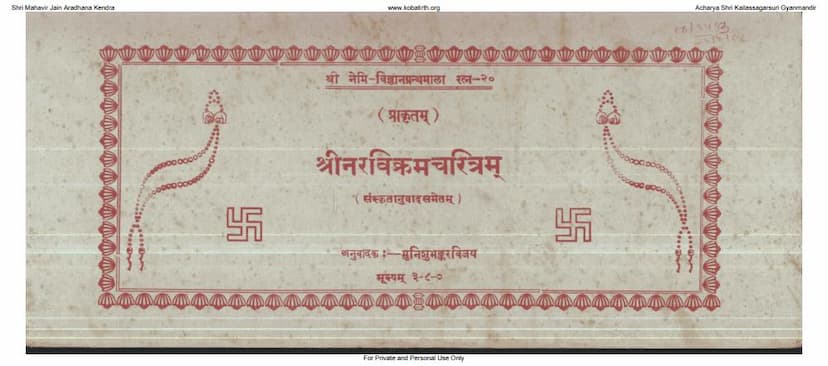Nar Vikram Charitram
Added to library: September 2, 2025
Loading image...

Summary
This Jain text, "Shree Narvikram Charitram," is the twentieth jewel in the "Nemi Vigyan Granthmala" series. It is a narrative about the life and deeds of Narvikram, a prince, and his father, King Narsingh. The original text is in Prakrit, composed by Acharya Shri Gunachandrasuri. This particular edition features a Sanskrit translation by Munishri Shubhankarvijay, who is also credited as the author/translator. It was published by Ajitkumar Nandlal Zaveri in Ahmedabad.
Key aspects highlighted in the text:
- Authorship and Lineage: The work is attributed to Munishri Shubhankarvijay, who is a disciple of Acharya Shri Vijaykastursuri, who in turn is a disciple of Acharya Shri Vijayvigyanasuri, who is a disciple of Acharya Shri Vijayanemisuri. This emphasizes the lineage and the reverence within Jain scholarly tradition.
- Purpose of the Text: The preface explains that "Narvikram Charitram" has been extracted from the larger "Shri Prakrit Mahavir Charitra" (specifically from the fourth chapter) to be useful for students of Prakrit. The Sanskrit translation is provided to make the text accessible to those familiar with Sanskrit.
- Central Theme: The core message of the story is that virtuous individuals, through righteousness and divine grace, achieve happiness in this life and ultimately liberation (moksha) from the cycle of birth, death, and rebirth.
- Narrative Outline: The story's plot points are summarized, including:
- King Narsingh's desire for a son.
- The birth of Prince Narvikram.
- Narvikram's prowess in various skills.
- His valor in defeating the demon Kalmegh.
- His marriage to Shilavati.
- The subduing of the elephant Matanga Jayakumara.
- The abduction of Shilavati.
- Narvikram being swept away in water.
- His reunion with his sons.
- Jayavardhan's attainment of the kingdom.
- Samantabhadra's discourse.
- Narvikram's reconciliation with his father.
- Narvikram's ascension to his father's throne.
- King Narsingh's renunciation, austerities, and eventual moksha.
- Narvikram's journey to the fourth heaven (Mahendra Loka).
- Publication Details: The book was published in Samvat 2008 (Vaisakh Sud 3), with financial support from various individuals whose names are listed, indicating community involvement in the publication.
- Content of the Narrative (Detailed): The text then delves into the story itself, beginning with King Narsingh's reign in the city of Chhatra. It describes his virtuous rule, his queen Bhadra, and the divine intervention leading to the birth of Prince Nandan (who later becomes Narvikram). The story follows Narsingh and Nandan's lives, including Nandan's becoming king. It then transitions to King Narsingh's past lives and the narrative of how Narvikram's story unfolds. The provided pages detail various events:
- The king's conversation with his ministers about the lack of a son.
- The arrival of a powerful ascetic, Ghorashiv, and his magical abilities.
- The king's consultation with Ghorashiv regarding his sonless state.
- Ghorashiv's advice and his subsequent display of powers.
- The battle between King Narsingh and Ghorashiv, resulting in Ghorashiv's defeat.
- Ghorashiv's repentance and his journey towards spiritual discipline.
- The lineage of King Avantisena and his sons Veer Sen and Vijay Sen, and Veer Sen's eventual exile and journey.
- Veer Sen's arrival in Sthandilapura and his meeting with the garland-maker Patala.
- The attempted seduction of Veer Sen's wife, Shilavati, by a merchant named Dehilo.
- Veer Sen's eventual departure and subsequent events.
- The reunion of Veer Sen with his sons.
- King Narsingh's renunciation and embrace of Jain principles.
- Narvikram's education and his mastery of various arts and sciences.
- The story of King Devsen and his daughter Shilavati, who is promised to the victor of a wrestling match against the mighty Kalmegh.
- Narvikram's victory over Kalmegh and his marriage to Shilavati.
- Narvikram's return to his kingdom and his father Narsingh's subsequent renunciation.
- The discourse of Acharya Samantabhadra, emphasizing the transient nature of worldly pleasures and the importance of spiritual pursuit.
- King Narsingh's realization and decision to embrace the Jain path.
- The text ends with Narvikram becoming king and Narsingh achieving moksha.
The provided text is a rich narrative of moral and spiritual teachings, illustrating the consequences of actions, the importance of righteousness, and the ultimate goal of liberation in Jainism.